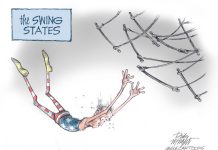A recent report from Hartford Funds suggests, “As the 2016 presidential election continues to unfold like a circus sideshow, now might be the perfect opportunity for us to stop for a second for a quick sanity check. Making an anxiety-based change today because of your political beliefs is more likely to be harmful than letting this partisan storm pass us by.”
This is sage advice. All investors are afflicted with biases, many unsupported by facts. We need to recognize our biases and not act on “gut” instincts, which are often damaging to our long-term investing success. Past performance is no guarantee of future results, but with political passions running white hot, stock market history provides objective information.
Sam Stovall, U.S. Equity Strategist for S&P Global Market Intelligence, examined the performance of the S&P 500 Index going back to 1900.
Stovall determined the price change of the S&P 500 from July 31 to Oct. 31 has been a reliable predictor of whether the incumbent or his party is re-elected or replaced in November. There have been 29 presidential elections since 1900. Republicans won 15 times and Democrats 14 times. The party occupying the White House changed 11 times.
When the S&P 500 was up for the three months prior to the election, the incumbent or his party was re-elected 81 percent of the time. This indicator failed only in 1968 (Humphrey lost to Nixon) and 1980 (Carter lost to Reagan).
The S&P 500 was an even better predictor of the replacement of the incumbent or his party. When the S&P 500 was down for the three-month period, the incumbent or his party lost 88 percent of the time. The only failure was in 1956 (Eisenhower defeated Stevenson).
Republican administrations are generally viewed as pro-business. Democratic administrations are usually cast as the opposite. Thus, conventional wisdom is stocks typically fare better when Republicans are in the White House.
Conventional wisdom is often wrong, especially when it comes to investments.
Since 1945 there have been six Democratic and six Republican presidents. Stovall examined compound annual growth rates for the S&P 500 during each presidency. The top three were Ford (Republican/+18.6 percent), Clinton (Democrat/+14.9 percent) and Obama (Democrat/+12.4 percent through 12/31/15). The bottom three were Nixon (Republican/-5.1 percent), George W. Bush (Republican/-4.6 percent) and Carter (Democrat/+6.0 percent).
Interestingly and perhaps counterintuitively, for the entire period from 1945-2015, the compound annual growth rate for the S&P 500 was +9.7 percent during Democratic administrations, a significant premium to the +6.7 percent with Republicans in the White House.
Hartford reminds us the last time our nation elected a new president, many investors were skeptical of Obama’s proposed policies and pulled out of stocks. The Dow Jones Industrial Average closed at 7949 on 1/20/09 (Obama’s first inauguration) vs. 18432 at the end of July 2016. In dollar terms, $10,000 invested in the S&P 500 at the end of January 2009 would have grown to $30,884.75 by the end of July 2016. I’ll leave it to the pundits to argue why, but the indisputable fact is investors who fled missed one of the greatest bull markets of all time.
Warren Buffett supports Hillary Clinton, but said the country is headed in the right direction and “no presidential candidate or president is going to end it.” Vote your conscience and don’t let politics skew your investing decisions.
Mickey Kim is the chief operating officer and chief compliance officer for Columbus-based investment adviser Kirr Marbach & Co. Kim also writes for the Indianapolis Business Journal. He can be reached at 812-376-9444 or [email protected].
[sc:pullout-title pullout-title=”On the Web” ][sc:pullout-text-begin]
To see the Hartford Funds report mentioned in Mickey Kim’s column, visit hartfordfunds.com/dam/en/docs/pub/whitepapers/MF7368.pdf
[sc:pullout-text-end]




